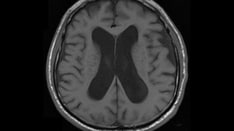This transcript has been edited for clarity.
Ladies and gentlemen, I am Christoph Diener from the University of Duisburg-Essen in Germany. This month, I'd like to report the most important results from the 8th European Stroke Organisation Congress, which took place at the beginning of May in Lyon, France. It was a great event, with approximately 2400 people attending in person.
Thrombectomy: A New Treatment of Choice for Basilar Thrombosis
There was particularly exciting news about the treatment of basilar thrombosis. You might remember that there were two small trials in China, the BEST and BASICS trials. These were unable to show a benefit of thrombectomy over best medical care in people with occlusion of the basilar artery, which was a surprise. Now we have two large randomized trials, again from China, which clearly show that thrombectomy is superior to best medical treatment.
The first study is the Basilar Artery Occlusion Chinese Endovascular (BAOCHE) trial. Patients with a National Institutes of Health Stroke Scale score of 6 or more and presenting within a time window of 24 hours were included.
The primary endpoint of a modified Rankin Scale score of 0-3 after 90 days was achieved with thrombectomy in 51 of 110 patients (46%) and with best medical treatment in 26 of 107 patients (24%). The odds ratio was 2.92 and clearly significant. There were also significant benefits for mortality with thrombectomy (31% vs 42%). There was only a very small increase in the risk for symptomatic intracranial hemorrhage with thrombectomy.
Next, there were data presented from the ATTENTION trial, which had a shorter time interval of 12 hours. Patients were randomized 2:1 to receive either endovascular treatment or best medical management.
Once again, the endpoint was a modified Rankin Scale score of 0-3 after 90 days, which was achieved in 104 of 220 patients (46%) with thrombectomy vs 26 of 114 patients (23%) with best medical management. This translated into a significant 2.1 risk reduction. There was also a significant reduction of mortality from 36% to 55%. Symptomatic intracranial hemorrhage was 5% with thrombectomy vs 0% with best medical management.
Investigators also presented results from the prospective ATTENTION registry, with more than 2000 matched patients in China, of whom, 1670 received thrombectomy and 462 best medical management. The outcome of a modified Rankin Scale score of 0-3 after 90 days showed a clear benefit in favor of thrombectomy, which was 1.42. The absolute difference was 12%. The absolute difference in the reduction of mortality was 10%.
It's amazing how consistent the results are. Our Chinese colleagues have to be congratulated for performing these trials in a very short time period. I think the debate we had is over. It's now clearly shown that thrombectomy is the treatment of choice in people with basilar thrombosis.
New Data on Thrombolysis
We have two substances for thrombolysis. One is tenecteplase, which is given as a bolus. We also have the established alteplase, where you need an initial bolus and then a 1-hour infusion.
The Canadian Alteplase Compared to Tenecteplase trial compared tenecteplase in a dose of 0.25 mg/kg body weight with standard dose of alteplase in 1600 patients. The primary endpoint was a modified Rankin Scale score of 0-1 at day 90, and the inclusion time was 4.5 hours.
There was no difference in the primary endpoint (37% for tenecteplase vs 35% for alteplase), and no difference in all the secondary outcome parameters and safety parameters.
What does this mean? I think it shows that most probably, tenecteplase is easier to use than alteplase and is also as effective. But the caveat is that in many countries, tenecteplase is not approved, not available, or not reimbursed. Whether this changes in the next few years, I don't know.
There was also a second study on thrombolysis done in Norway, the NOR-TEST 2 trial. This study used a higher dose of tenecteplase, 0.4 mg/kg body weight, against alteplase. The study had to be terminated after 216 patients had been included because there was a significant increased risk for hemorrhage with tenecteplase and a higher mortality. The most likely explanation is that the dose of tenecteplase was too high.
There was also a study from Melbourne in mobile stroke units wherein tenecteplase was compared with alteplase. It was a small study, and therefore, no difference was shown in clinical outcomes. However, there was a benefit for the size of the ischemia in perfusion CT with tenecteplase.
Then we had data on a very interesting new antithrombotic. Glenzocimab is a monoclonal antibody directed against the human platelet glycoprotein GPVI. This antibody inhibits thrombosis but does not lead — at least in animal experiments — to an increased risk for bleeding.
The ACTIMIS study investigated the safety of 1000 mg of this new drug against placebo in 106 patients who received thrombolysis. There was no difference in any bleeding, but there was a clear difference in favor of glenzocimab in the risk for symptomatic intracranial hemorrhage (1% vs 8%) and mortality (8% vs 19%). This now has to be proven in the larger phase 3 trial.
Other Studies of Interest
There were also several other trials of interest that I'd like to briefly mention. One study showed that lowering blood glucose with the GLP-1 [glucagon-like peptide 1] agonist exenatide in patients with acute stroke is not effective at reducing disability.
Then we had a study of tranexamic acid in people who have had an intracranial bleed on a non–vitamin K antagonist. The study didn't show a benefit, although this is irrelevant because now we have seen reversal agents both for dabigatran and the Xa inhibitors.
There was a meta-analysis of all the patients in a randomized study wherein local thrombolysis was investigated in intraventricular hemorrhage compared with best medical treatment. It showed a benefit both for functional outcome and a 50% reduction in mortality. Clearly, I think most of us in clinical practice will use this method.
There was a study in 330 patients, which compared thrombectomy with general anesthesia vs sedation. Investigators found no difference. Again, this is not really relevant because usually, thrombectomy is done in sedation. If sedation is not possible, then general anesthesia is used.
Last, there was a study in severely affected stroke patients wherein early tracheostomy was compared with standard tracheostomy in 330 patients. This study also found no difference. So obviously, we should keep our standard approach that we used up to date.
I'd like to also issue a final caveat. At this congress, a number of studies were presented which had either a very small sample size or were terminated prematurely for whatever reason. And my caveat is, please do not consider the results of these studies. They have no impact on what we do with our patients in everyday clinical practice.
Ladies and gentlemen, it was an exciting stroke congress in Lyon, with results which will change our practice for the next years.
I'm Christoph Diener from the University of Duisburg-Essen in Germany. Thank you very much for watching and listening.
Follow Medscape on Facebook, Twitter, Instagram, and YouTube
Medscape Neurology © 2022 WebMD, LLC
Any views expressed above are the author's own and do not necessarily reflect the views of WebMD or Medscape.
Cite this: Hans-Christoph Diener. A New Treatment of Choice for Basilar Thrombosis, Plus Other Recent Stroke Data - Medscape - Jun 13, 2022.














Comments